
The Navy Department Library
Chapter III. Know Your Boat!
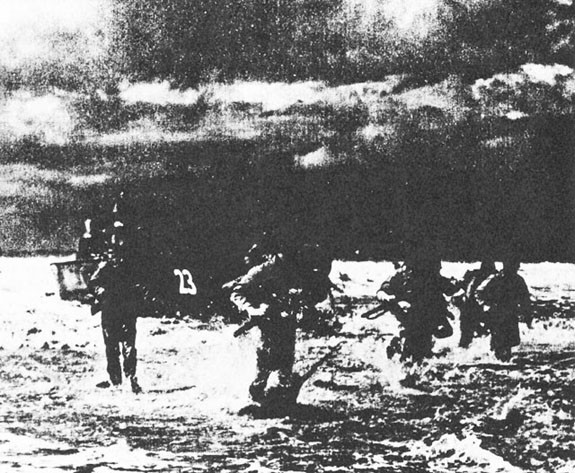
* * * * *
Suppose you had just made that first landing on the beach and an equally green LCVP crew member yelled at you, "Hey, Mac, lemme have that handle on the wall so's I can use it on this gizmo to let down the gate!" Could you figure out what he wanted? With a little luck you probably could, but when beaching the "VP" or "M(3)" things can't be left to luck. Each move must click, and to make everything run smoothly the crew member must know his boat from ramp to transom.
Read through this chapter with care, then go back and study it. Pair off with a buddy and hold a couple of quiz sessions until you know the name of each piece of gear, and use those terms until you find yourself rattling them off effortlessly.
What does the crewman need to know about the LCVP and the LCM? A good deal--but learning takes place "on the double" since boat crews will be working in the "VP" and "M(3)" at the same time they use this manual.
--9--
Characteristics of the LCVP
The LCVP was designed to run through the surf to a beach, lower a ramp, unload men and cargo, back off, or retract, through the breakers and return to the transport or dock from which it started. These requirements decided its characteristics. Some of the qualities that engineers had to consider were:
Speed--the boat had to get into the beach fast under fire.
Lightness--the "VP" had to be carried aboard a transport and launched over the side.
Power--it had to run aground and back free.
Toughness--it had to be able to take a terrific pounding from the surf and from rocky or coral beaches.
Maneuverability--the boat had to handle smartly, respond quickly and exactly to the coxswain's touch.
Range--the LCVP couldn't take "time out" to refuel every hour or two.
Capacity--to earn its keep it was essential that the boat be able to land a good-sized load.
Armament--the safety of the crews and cargo could not be disregarded.
Simplicity--a large number of crews had to be trained--and fast--so the boat had to be easy to handle and care for. Equally important it had to be mass-produced with interchangeable parts.
How these requirements were met is shown by the following formation. The LCVP as it now rides the swells is a seaworthy 81/2-ton boat 36 feet long with a draft forward of about 12 inches and 31/2 feet aft. She carries a crew of four (coxswain, engineer, and two deck hands) and will transport 36 men or 8100 pounds of cargo. With load she will travel ten to twelve miles per hour (the speed of the "VP" and "M(3)" is frequently expressed in miles rather than knots). Without cargo this speed can be stepped up to approximately 15 m.p.h. Two 100-gallon fuel tanks provide a range of about 100 miles at normal speed.
Armor plate sheathes the forward portion of the hull and provides protection against small-arms for crew and cargo. In combat, two .30 caliber machine guns in circular steel gun wells are manned by the deck hands during the run to the beach.
A Gray Marine Diesel engine which delivers 225 horsepower drives the LCVP efficiently. Simplified controls enable the coxswain to handle this power-plant with a single lever for forward and reverse gear, and speed. There is a single screw and rudder. (The action and effect of the screw and rudder are discussed fully in Chapter VI.)
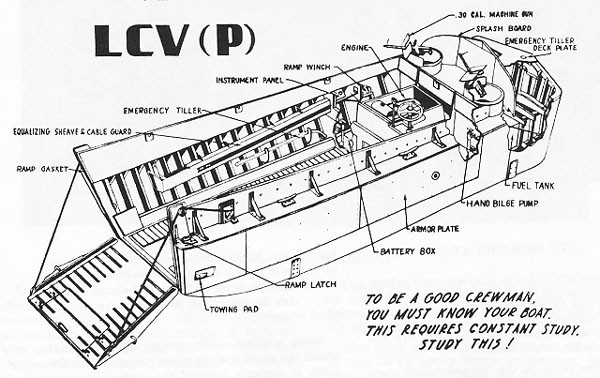
--10--
The cut-away drawing of the LCVP on page 10 supplies a view of the boat as seen from above. This plainly shows one of the boat's most important characteristics, the ramp,. Operated by steel cables, the ramp usually is controlled by the engineer from a winch mounted on the bulkhead to starboard from the engine.
One important feature of the "VP" does not show in the illustration. This is the skeg, an extension of the keel, which supports the boat when it is beached. The skeg is a vital part of the "VP's" design. It protects the steering mechanism from harm and, since it extends past the screw, serves to keep the screw off the bottom where it might otherwise become fouled in the sand or mud, bent, or otherwise damaged. At the first opportunity the trainee should examine the underwater construction of the boat and note the relative positions of skeg, rudder, and screw.
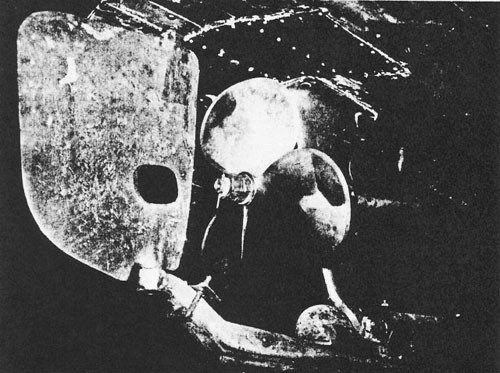
LCVP Nomenclature
"Nomenclature" is a ten-dollar word which refers to the names given the various parts and fittings of the LCVP. Many of the terms the boat crew trainee will need to know are shown in the accompanying illustration. They are explained in some detail below.
Ramp--the ramp is the "drawbridge" over which cargo, men, and vehicles move to the beach. The hinged, steel cover of the window in the ramp, which swings inward and downward, may be lowered to give the coxswain a clear view ahead when in safe areas and on calm water.
Ramp gaskets--are spongy strips against which the ramp presses when raised. When the ramp is properly secured the gasket provides a water-tight seal.
--11--
Ramp latches--also called "dogs," are hooks which hold the ramp in position when it is raised.
Hand bilge pumps--there are two of these, one abaft the coxswain, the other a short distance forward from the ramp winch. They are used to remove bilge water when the engine driven pump fails to operate.
Gun wells--the two armored pits upon which .30 caliber machine guns are mounted. They are covered by round wooden plates during training since water is likely to be taken in through the openings, even in a moderate surf.
Splash board--located behind the gun wells, the splash board defects breakers to some extent when the "VP" is retracting.
Transom--the rearmost covered part of the stern, abaft the splashboard.
Emergency tiller deck plates--a small plate set in the stern. When uncovered it reveals the top of the rudder stock, the metal bar to which the rudder is attached.
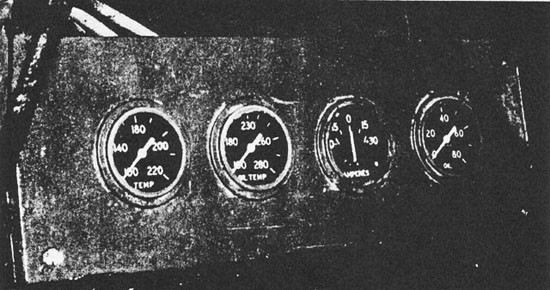
Instrument panel--located to starboard of the engine, this supplies the engineer with information on water temperature, amperage, oil pressure, and oil temperature. A tachometer on the port side near the wheel tells the coxswain the number of revolutions per minute made by the engine.
Emergency tiller--a curved bar equipped with an opening at one end which fits onto the rudder stock. It is used if the steering mechanism fails.
Fuel fills--inlets to the diesel oil tanks are located on the transom on either side of the center line.
Sampson post--a short post with cross arms located amidship on the transom. A line may be fastened to it for towing purposes.
Engine box--protective covering with removable lid around the VP's diesel engine.
Coaming--solid raised framework around the cockpit and cargo space of the "VP." It is designed to reduce the amount of water shipped over the side.
Equalizing sheave and cable guard--the sheave, an inner wheel of a block or pulley, is a part of the tackle with which the ramp is lowered. It is located in the cable guard, a protective framework covering the ramp cable running forward from the ramp winch.
Clutch and throttle control--usually located to starboard of the wheel, this lever controls forward and reverse movement of the boat and its engine speed.
This brief identification of important parts of the LCVP omits much information. However, other pieces of gear are covered in more
--12--
detail later. For instance, engine parts from surge tank to salt water cooling system are the topic of paragraphs dealing with operation and maintenance in Chapters V and VI.
Characteristics of the LCM(3)
The LCM may be thought of as a big and chunky older brother to the LCVP. They show a distinct family resemblance as brothers often do, but the "M(3)" has larger "muscles." It carries more cargo, has more power, and is more difficult to operate.
Like the "VP," the "M(3)" must pound in through the breakers, beach, unload, retract, and return successfully for another load. Into its sturdy all steel hull the same qualities required of the LCVP have been built: speed, lightness, power, toughness, long cruising range, sizeable cargo capacity, maneuverability, armament, and simplicity. In the hands of a capable crew, this boat has what it takes to pour men and material onto a beachhead.
The LCM is 50 feet long with a beam of 14 feet. She weighs about 25 tons and has a cargo space 32 by 91/2 in which a 30-ton tank can be carried. (Because of this ability to ferry tanks, this boat is sometimes called a tank lighter.) If not transporting a vehicle, the "M(3)" can take 60,000 pounds of cargo or 120 troops ashore on each run.
The tank lighter's power plant consists of two 225-horsepower Gray Marine Diesels supplied by twin fuel tanks with a total capacity of 400 gallons. This is sufficient oil for a 125-mile trip. Two screws and twin rudders drive and direct the LCM through the water at a normal operating speed of 10 miles per hour.
A five man crew is required to handle the LCM: a coxswain, engineer, and three deck hands. The coxswain must be unusually skilled in handling boats since the task of manipulating the controls for two engines is fairly complicated. Also, the boat handles in a tricky fashion because of its shallow draft and high freeboard. So that it can be driven well up on the
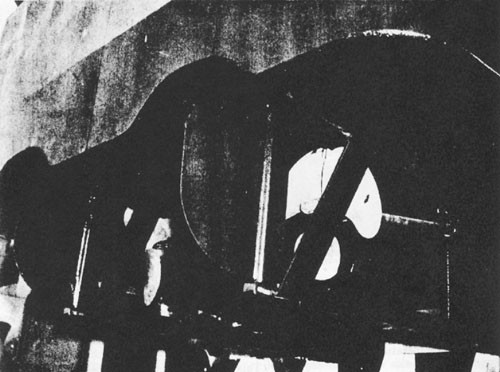
--13--
beach, the tank lighter has a very shallow draft forward, and but a few feet aft. A skeg gives protection to rudders and screw. As in the case of the LCVP, armor plating protects the crew, and machine guns mounted aft near the pilot house provide a measure of defense from shore fire and strafing.
There are several ways in which the LCM is distinctly different from the LCVP. The twin engine construction is but one of these differences. Others include the power operated ramp, the wing tanks, and the more complicated structure of the after section: engine room, lazarette, and pilot house.
The heave ramp is driven by the port engine and operated by the coxswain. When ready to lower it, he instructs one of the deckhands to release the ramp safety chain or hook, then depresses a foot pedal in the pilot house to free the ramp latch, engages the clutch of the ramp hoist control, and lowers away. (Details of ramp operation are presented in Chapter VI.)
The wing tanks extend the length of the LCM. They are divided into water-tight compartments, as is the double hull, and are reinforced by stout metal beams. The buoyancy these tanks provide will keep the boat afloat even when the cargo space is flooded.
Directly forward of the pilot house a small hatch gives access to the engine room. The twin diesels are mounted to port and starboard of the keel and are separated by a catwalk, from which the engineer can work. Abaft the engine room is a second tiny compartment or space, the lazarette. The steering mechanism is located here. A second small hatch on the transom abaft the pilot house open into the lazarette.
The pilot house is made of steel plate and is equipped with peep holes to eliminate the need for the coxswain to expose his head to small arms fire when moving toward the beach. Within are the steering wheel, instrument panels for each engine, and engine and ramp controls. Another value of the pilot house is the protection it affords against heavy surf.
LCM(3) Nomenclature
Since some of the terms used with the LCM have the same definition as those used with the LCVP, the nomenclature covered here will be limited to that not given a few pages earlier. The meaning of terms discussed below will be more easily understood and learned by boat crew members if they refer to the picture of an LCM(3) below.
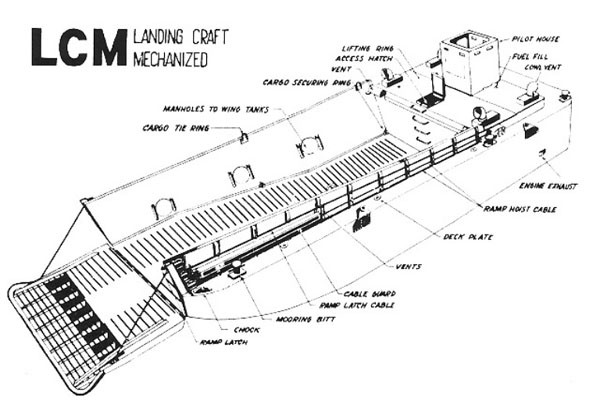
--14--
Ramp latch--a hook, controlled from the pilot house, which must be released before the ramp can be lowered. The Ramp latch cable is the steel cable running along the port coaming.
Cable guard--a box-like sheath which protects the ramp hoist cable near the ramp.
Hoisting pads--metal plates welded to hull. Each of the four supports a pad eye or ring by means of which the boat is lowered into the water from a transport.
Deck plates--threaded metal caps which seal the openings to wing tank compartments. If water gets into the wing tanks, it can be pumped from them by removing the deck plates and inserting a compartment pump.
Ramp hoist cable--heavy wire cable which extends aft from the ramp to a winch operated by means of the port engine.
Cowl vents--four in number, these ventilators on either side of the pilot house assure fresh air in the engine room. There are also two engine-room vents which open into the after end of the cargo space.
Access hatches--the forward hatch directly in front of the pilot house leads to the engine room. The access hatch to the lazarette is abaft and to port of the pilot house.
Cargo tie rings and cargo securing rings--are located at the top and bottom of the port and starboard bulkheads of the cargo space. Lines are run through these rings to secure cargo in place.
Pilot house--control center of the LCM, this houses the steering wheel, twin engine controls, instrument panels, and controls for the ramp latch and ramp hoist winch.
Manholes to wing tanks--a manhole opens into each wing tank compartment from the cargo space. Similar openings provide entry to the double hull. The manholes allow repair crews to patch and weld damaged hulls or broken supporting beams.
Operating Equipment for the LCVP & LCM
The traveller on bicycle and motorcycle or in jeep, scout car, or tank has one advantage over the man in a landing boat. If something goes wrong with his means of transportation he can nearly always get out and walk. Or he can secure to a nice, cozy foxhole while waiting for a repair unit to come up.
In an LCVP or LCM the boat crew members are on their own. They can't get out and walk if their transportation fails them and there are no foxholes, cozy or otherwise, in the breakers or swells. Therefore, it is a good idea, an excellent idea, for the boat crew to make sure that all equipment needed for ordinary operations and emergencies is on hand and stowed in the proper place.
A list of essential items, needed in every landing boat, has been prepared by the Fleet. This equipment is required if normal operations are to be carried out safely. Each crew member will need to become familiar with the list. Some of the items are needed for successful boat handling, others for engine care, and still others for miscellaneous purposes. Both the LCVP and LCM carry similar equipment. Where there is a difference, take note of it! Items carried on boats during normal operations are marked with an asterisk (*).
Operating Equipment Used in Boat Handling
The equipment needed here should be gone over during the daily boat check. Any pieces which are missing should be obtained at once. Although the equipment is described here, it is also presented in check-list form in the appendix, a form more convenient for the daily boat-check than the list below.
* Danforth Anchor, Mark 2. The LCVP carries one 30-pound anchor. The LCM anchor is the same type but weighs 70 pounds.
** Anchor line and chain. Fifty fathoms of three-inch line are carried in the LCVP. The LCM has a 75 fathom four-inch line. (One fathom=6 feet.)
* Anchor buoy. A small buoy attached to the anchor by a light line. It marks the position of the anchor and shows where to find it if the anchor line parts.
* Hoisting sling. One is carried by each boat. Slings are used for hoisting and lowering the boat from a transport to the water.
* Grapnel and line. Both boats carry a four-pound grapnel and fifteen fathoms of line. The grapnel is a small anchor with several arms and is used as a drag.
* Emergency tiller. A hollow bar with one end shaped to fit the top of the rudder stock. This tiller is used if the steering mechanism fails. Both the "VP" and "M(3)" carry it.
--15--
* Bowline and sternline. Used to secure the boat to the dock. The LCVP carries a three-inch, three fathom line for the bow and stern. The LCM has four-inch lines which are five fathoms in length.
* Anti-broaching line. A three and one-half inch line to prevent broaching or free a boat which has broached. It is manned by the beach party.
Towing line. The "VP" uses an eight fathom three-inch line. The tank lighter has a four-inch line which is 18 fathoms long. (Anti-broaching lines also may be used for a tow.)
* Life jackets. Kapok jackets are used in both boats. One is required for every man aboard.
* Life ring buoys. Two per boat are carried.
* Buckets, brooms, and swabs. Two galvanized buckets are allotted to each boat. (Two more are to be filled with sand for use in fighting fires.) One broom and one swab are standard equipment.
* Rope fenders. Although four per boat are required, six are desirable.
* Ramp jacking lever. One of these tools is allowed per boat.
* Boathooks. Two of these metal tipped poles should be at hand. The LCVP hooks are eight feet long; the LCM's are twelve feet.
* Compass. Mounted, magnetic boat compasses are required. The magnesyn compass also is commonly used, especially on the LCM.
* Hand bilge pumps. The LCVP hand pump is built in. The tank lighter's is portable.
Tarpaulin. These protective canvas coverings are found on both boats.
* Cranking bar. Used for operating the LCVP ramp winch. Also carried on the LCM for emergency use.
Ramp cable. An extra length is kept at hand in the event that a frayed cable needs immediate replacement.
* Ramp hoisting jiggers. Block and tackle for raising the ramp if the winch fails.
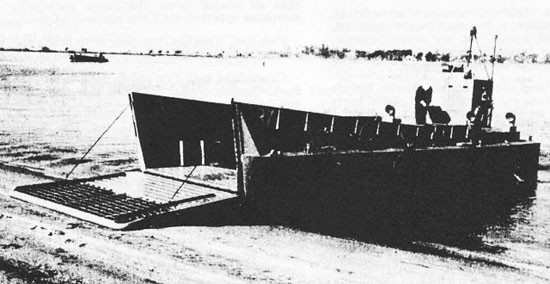
Operating Equipment Used With the Gray Marine Diesel Engine
The landing boat is helpless as a baby without its power plant in running order. The diesel must be kept in excellent condition at all times to avoid an engine failure that might easily result in damage to the boat or even loss of life. The essential equipment needed to keep the marine engine in the best possible order is, therefore, extremely important. When making the daily engine check, the engineer
--16--
will want to be certain that all motor maintenance gear is accounted for and up to standard. Asterisks (*) denote articles carried during normal operations.
* Batteries (6 volt). The LCVP has two storage batteries; the LCM has four since it is twin engined. All of the items which follow are identical for both boats.
* Fuel tank sounding rod. Used to determine the quantity of fuel oil remaining in tanks.
Alemite grease gun and transmission grease gun.
* Fresh water. A five gallon container is kept filled to replenish the liquid in the fresh water cooling system.
Lubricating oil. A five gallon container is kept filled to keep the engine oil supply at a proper level.
* Transmission grease and water pump grease. A one-pound can of each is kept at hand for immediate use.
Gray Marine Diesel Instruction Book. A handy reference when something unforeseen comes up.
* Took kit. Contains nine-inch screwdriver, eight-inch pliers, a five-piece box wrench set, six-piece end wrench set, ten ounce hammer, and ten-inch crescent wrench. Hacksaws and spare blades also are recommended.
Spare tubing. Such tubing should include spares for fuel and oil lines, and spare hoses and clamps for water lines.
Miscellaneous Operating Equipment
Every boat needs certain types of miscellaneous gear for signalling, first aid purposes, and so forth. These items are included in the list which follows. Here again, all items except the sump pump are in both the LCVP and the tank lighter.
Sump pump and hose. (Standard equipment in the LCM only.) The sump pump removes water from hard-to-reach sections of the bilge, or oil from fuel tanks. It is hand operated.
* Carbon Dioxide (CO2) fire extinguisher. Two CO2 extinguishers are kept aboard. They are the 15-pound models.
* Drinking water. Two five gallon water breakers are required.
"C" Rations. One day's "C" rations per man are carried aboard.
Portable Bottle Lantern. A sturdy lantern, this is powered by two "A" batteries and can be used when light is needed or for emergency signal purposes.
Flashlights. Red, white, and green flashlights are used for signals.
* Answering pennant and semaphore flags. Two semaphore flags and one answering pennant are essential for proper boat communications.
Tapered wooden plugs. A set of these is carried. They are used to stop up small holes such as might be made by .30 or .50 caliber projectiles.
Medical Kit. A small standard kit may be needed at any time for first aid work. Be sure that all needed items (bandages, antiseptic, morphine syrettes, etc.) are replaced as used.
Fish line. This line, complete with hooks and sinkers, has been a life saver more than once.
Camouflage net. One net is carried by each boat. They are effective when correctly used and kept in condition.
The LCM, in addition to the gear listed above, carries running lights and a range light, and is often equipped with an electrically operated horn. It is desirable to have additional bulbs aboard the tank lighter for these lamps and for the lights that are sometimes mounted in the engine room.
If you, as a crew member, can identify the various parts of the LCVP and LCM given above, you have a nodding acquaintance with the boat you will man. There is much more to learn! One of the best ways is to learn on the job. Keep this manual handy and check your knowledge of nomenclature aboard the "VP" or "M(3)".
--17--
[End of Chapter 3]



